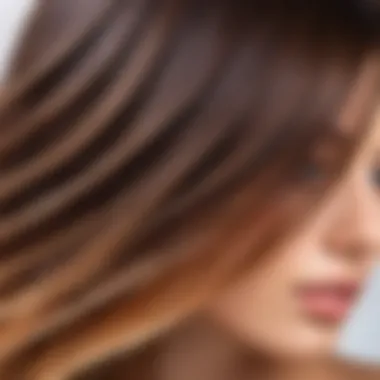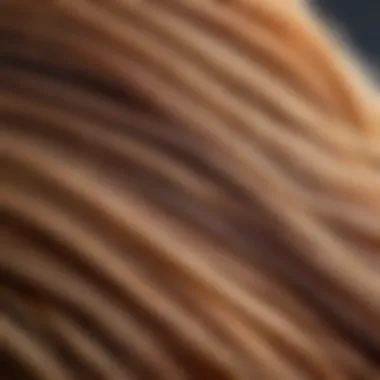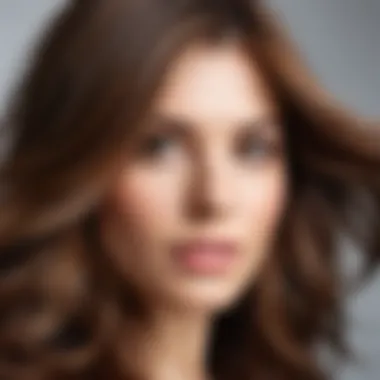Understanding Hair Layers: A Comprehensive Guide


Intro
Hair is a powerful element of personal expression and style. Understanding the various layers of hair can significantly enhance the way one styles, maintains, and showcases their locks. Each layer offers unique potential for texture and movement, influencing how hair falls and frames the face. This guide delves into the significance of hair layers, explores different layering methods, and provides tailored advice on care and styling options.
Hair Layers Explained
Hair layers refer to the technique of cutting hair in varying lengths, creating shapes and dimensions. This approach can transform flat hair into something dynamic and lively. Not only do layers add visual interest, but they also impact the overall texture and feel of the hair.
Hair layering can be classified mainly into three categories:
- Long layers - These give a subtle effect and are great for adding volume without losing length.
- Short layers - These create dramatic effects and are useful for those who wish to make a statement.
- Blunt layers - These maintain a strong edge while allowing for texture and movement.
Importance of Layering
In hairstyling, the impact of layers cannot be understated. They play a crucial role in determining how hair moves and behaves. By understanding the significance of layers, individuals can make informed decisions that bring out the best in their hair type.
"Layers can elevate your hairstyle, giving it a polished and dynamic look. Being aware of how layers function can significantly improve your hairstyling choices."
Choosing to layer hair depends significantly on one’s hair type, texture, and desired look. For instance, those with thick hair might benefit from shorter layers to reduce bulk, whereas finer hair could require longer layers to add volume.
Care for Layered Hair
Effectively maintaining layered hair is key to keeping it looking healthy and stylish. Here are several practical tips:
- Regular trims: Keeping the ends fresh helps maintain the layered shape.
- Quality products: Use shampoos and conditioners designed for your hair type.
- Styling tools: Invest in good tools to prevent heat damage.
- Hydration: Regularly deep condition hair to keep it healthy.
Final Thoughts
Grasping the basics of hair layering helps one navigate the often complex world of hair styling. From layering techniques to maintenance tips, this guide aims to equip readers with useful knowledge that can transform their hair care routines. By choosing the right layering techniques and caring for layered hair, anyone can make their hair a true expression of personal style.
Prelude to Hair Layers
Hair layers play a pivotal role in the world of hairstyling. They are not just about aesthetics; they influence the overall structure, movement, and texture of hair. Understanding hair layers helps individuals make informed decisions when choosing hairstyles that complement their face shape and hair type.
Defining Hair Layers
Hair layers refer to the various lengths of hair throughout a hairstyle, created by cutting the hair at different elevations. This technique can add depth and dimension, allowing for more versatility in styling. Layers can range from subtle to dramatic, depending on how much volume or movement one desires. By defining hair layers, one can achieve a tailored look that highlights favorable facial features.
Importance of Hair Layers in Styling
The importance of hair layers cannot be overstated. They directly impact how hair behaves and styles. Layers can:
- Add Volume: For those with fine hair, layers create an illusion of fullness.
- Enhance Movement: Layers allow hair to flow more freely, avoiding a flat appearance.
- Frame the Face: Specific layers can accentuate the face shape, enhancing facial structures.
- Create Versatile Styles: Layered hair can be styled in various ways, providing flexibility.
"The art of layering is fundamental to modern hairstyling, and mastering it can unlock countless styling possibilities."
By exploring the intricacies of hair layers, individuals can enhance their hair care routines and styling techniques.
Types of Hair Layers
Understanding the types of hair layers is essential for both styling and managing hair effectively. Each type offers distinct characteristics and benefits that can enhance the overall look and feel. Choosing the right layering method is vital. It influences not only the aesthetic but also how one can maintain style and manage hair health.
Long Layers
Long layers are a popular choice which involves cutting the hair into a series of long layers, maintaining more length overall while providing movement and volume. This technique is suitable for those who want added volume without drastically reducing their hair length.
The advantages of long layers include:
- Movement: They create soft waves and a breezy appearance.
- Versatility: This style easily adapts for various looks, from sleek to messy.
- Maintenance: Regular trims help keep them looking fresh while allowing for growth.
Those with straight or slightly wavy hair often benefit from long layers, as they enhance natural texture.
Short Layers
Short layers are cut higher up the hair, resulting in more noticeable volume. This style suits those looking for a bold, textured look. Short layers can help add lift and body, making them ideal for finer hair types.


Benefits of short layers include:
- Volume Boost: They add significant lift at the roots,
- Styling Freedom: Short layers provide various styling options, from tousled looks to neat finishes.
- Lightweight Feel: With less weight, they are easy to manage.
However, this style does require regular maintenance to keep the layers looking flattering.
Face-Framing Layers
Face-framing layers focus on softening a person's features. These layers start around the jawline and gradually blend into longer sections, adding depth to the overall hairstyle. They are particularly useful for highlighting cheekbones or jawlines.
Some important aspects of face-framing layers are:
- Enhancement of Facial Structure: They strategically accentuate facial features.
- Adaptable for All Lengths: This type can be incorporated into both long and short hair.
- Framers: These layers promote a more approachable and softer appearance.
This style works well for all hair types, from straight to curly, and tends to complement various face shapes.
Choppy Layers
Choppy layers create a textured look, often with uneven ends for a playful aesthetic. This is suitable for individuals wanting a more edgy or fashionable appearance.
Notable features of choppy layers include:
- Texture: They add dimension and movement to the hair.
- Stylish Edge: Suitable for those aiming for a contemporary look.
- Customization: Can be tailored with various lengths and choppiness, making each style unique.
Choppy layers are more often found in medium to long hairstyles. They require special attention with styling products to maintain the desired hold.
Choosing the right type of layer can greatly influence the overall styling journey. Each type has its own benefits, and understanding these can lead to a more tailored and satisfactory hair experience.
Layering Techniques
Layering techniques are fundamental in the realm of hairstyling. These methods not only affect the overall appearance of hair but also play a significant role in how hair behaves and manages its volume. Different techniques can create distinct outcomes for texture, movement, and style. The choice of a layering technique directly correlates with individual hair types, styles preferences, and maintenance routines. Knowing how to effectively use these techniques can enhance the beauty and functionality of layered hair.
Point Cutting
Point cutting is a technique where the hair is cut vertically, removing small sections to create soft ends. This method helps avoid the bluntness often associated with traditional cutting. The benefit of point cutting is that it can add texture and remove weight from thick hair. It also helps in blending layers smoothly, which is essential for maintaining a natural look.
Considerations include the level of skill required. It needs precision to not disturb the overall shape of the haircut. For those looking for a more textured appearance, point cutting is often recommended.
Slide Cutting
Slide cutting involves gliding scissors along the hair shaft while cutting. This technique produces a feathery finish and helps to blend layers seamlessly. The sliding motion helps to remove bulk without changing the length dramatically. As a result, hair maintains volume while achieving a more lived-in feel.
Users should be cautious, as improper technique may lead to uneven results. Slide cutting works best on medium and fine hair textures. It’s a highly effective way to achieve movement without compromising shape.
Razor Cutting
Razor cutting employs a razor blade instead of standard scissors. The razor glides through the hair, providing a soft, wispy effect. This method is suitable for creating layers that appear soft and flowing. The texture created through razor cutting can add significant movement to the hair, making it an appealing option for those seeking a modern, light aesthetic.
However, one must consider the hair's health. Razors can be damaging if used excessively or on already compromised strands. For healthy hair, razor cutting can be transformative, providing an airy finish.
Clipping Method
The clipping method is a technique that uses sectioning clips to hold hair in place while cutting. It allows for a structured approach to layering. This method is particularly useful for assembling a clear vision of where layers will go. By carefully sectioning and clipping, it gives control over the cut and helps avoid excess tension in the hair during cutting.
It is a beneficial technique for beginners, as it facilitates a measured, methodical approach. Using clips can also help in visualizing how layers will interact, which can lead to more satisfying results.
Effective layering is an art that requires practice, patience, and knowledge of different cutting techniques. Knowing which method to apply will allow for versatility and flair in any hairstyle.
Choosing the Right Layering Technique
Selecting the appropriate layering technique is fundamental in achieving the desired hairstyle. Each method offers distinct outcomes and can significantly alter the overall look and feel of hair. Understanding this topic aids individuals in making informed decisions that align with their style preferences and requirements. The right technique considers hair type, desired volume, and the specific movement one seeks from their hair. This section will explore those considerations in detail.
Assessing Hair Type
Understanding your hair type is crucial before choosing a layering technique. Different hair types—straight, wavy, curly, or coily—react uniquely to layering. For example, fine hair may benefit from long layers to add volume, while curly hair might require shorter layers to prevent bulkiness. Consider the following while assessing hair type:


- Texture: Is your hair fine, medium, or coarse?
- Thickness: Do you have thin strands or thick hair?
- Natural Wave: Is your hair straight, wavy, or curly?
Knowing these factors helps to guide your choice of technique, ensuring that the layering serves to enhance your natural beauty rather than detract from it.
Determining Desired Volume and Movement
Volume and movement are integral to hairstyle. The right layering technique can elevate both, adding a dynamic quality to the hair. For instance, those seeking volume may lean toward choppy layers, which add texture and body. If smoothness and a sleek look are preferred, slide cutting could be a better choice. Factors to consider include:
- Desired Look: Do you prefer something sleek or more voluminous and textured?
- Hair's Response: How does your hair typically react to layering?
Being clear on these aspects before the haircut will help in discussing goals with a stylist.
Consulting with Professionals
Engaging with a professional stylist can significantly enhance your layering experience. They possess the expertise to assess your hair type and goals effectively. When consulting with a stylist, bring:
- Photos: Visuals of desired styles can help convey your vision.
- Questions: Prepare inquiries about how different techniques might affect your hair.
The stylist can offer tailored recommendations based on their observations. This collaboration often leads to an outcome that aligns closely with your expectations, ultimately resulting in hair that complements your features well.
"Personalized advice can elevate a simple haircut into an iconic statement.”
Understanding the right layering technique contributes to not just trends in hairstyling but also boosts confidence. A strategic choice allows individuals to express themselves through their hair, creating a look that resonates uniquely with them.
Impact of Hair Layers on Texture and Movement
Understanding how hair layers influence texture and movement is crucial for anyone looking to elevate their hairstyling game. Layers can dramatically alter how hair behaves, providing benefits that go beyond aesthetics. Properly executed layers can enhance the hair’s natural characteristics, making it easier to style and manage. This section delves into two fundamental aspects of hair layering: enhancing natural texture and creating movement and dimension.
Enhancing Natural Texture
Layers can serve as a powerful tool in showcasing the inherent texture of your hair. When done correctly, they can amplify the natural waves, curls, or straightness, allowing the unique qualities of your hair to shine through. For instance, if a person has wavy hair, incorporating layers can help define those waves rather than weighing them down with a one-length cut.
Consider the following points when enhancing texture through layers:
- Customized Cuts: Different hair types require tailored approaches. For example, thick hair might need more aggressive layering to avoid bulk, while finer hair may require subtler layers to maintain volume.
- Product Application: The right styling products can enhance the effect layers have on natural texture. Texturizing sprays or mousses can give definition to curls and waves, making them look lively and full.
- Maintenance: Regular trims are essential in preserving the integrity of layered hair. Split ends can hinder the texture you aim to enhance, leading to a frayed look.
Creating Movement and Dimension
Movement and dimension are pivotal in making hairstyles dynamic. Layers interject movement into a hairstyle, preventing it from appearing flat and lifeless. This is particularly significant for styles intended to be versatile, as layers can turn an ordinary look into something that has depth and flow.
Key considerations for creating movement and dimension include:
- Layer Depth: The depth of the layers can dictate the extent of movement. Tiers of varying lengths can add a bouncy, flowing quality to hair, encouraging it to move naturally with the person’s movements.
- Face-Framing Layers: Incorporating face-framing layers can add dimension while complimenting one’s features. This technique draws attention to the face and creates a softer silhouette.
- Styling Techniques: Utilizing specific styling methods, such as curling or blow-drying with a round brush, can further accentuate the movement created by layers.
"Layers are not just about cutting hair; they are about crafting a style that resonates with the hair's natural character."
Care and Maintenance of Layered Hair
Taking care of layered hair is essential for maintaining its shape, texture, and overall health. Layered hairstyles can enhance volume and dimension but require specific products and techniques to achieve the desired look. Proper care not only helps in showcasing the layers beautifully but also preserves hair vitality, reducing damage and split ends.
Choosing the Right Products
Selecting the right hair products is fundamental to sustaining layered hair. Products should cater to the hair type, whether it is coarse, fine, straight, or curly. For layered hairstyles, volumizing shampoos and conditioners can amplify lift at the roots, ensuring each layer is distinct. Additionally, leave-in conditioners help to keep hair hydrated and manageable, allowing for easy styling and reducing frizz. Here are some product types to consider:
- Moisturizing shampoos: Keep hair hydrated and healthy.
- Volumizing sprays: Add lift at the roots and enhance layers.
- Heat protectants: Essential if styling tools are used regularly.
Regular Trimming and Updates
Regular trims are vital for layered hair. Layers can lose their shape if not maintained properly. Plan for trims every 6 to 8 weeks for optimal results. This practice not only helps to retain the style but also allows for the removal of split ends. Updating layers can also spice up the look as trends change and personal style evolves. When visiting a hairstylist, discussing desired updates can lead to refreshed and modern styles.
Styling Techniques for Layered Hair
Effective styling techniques can dramatically enhance the appearance of layered hair. Each method has its unique attributes and can help to define and accentuate the layers.
Blow-Drying Methods


Blow-drying layered hair correctly contributes to its volume and texture. One effective technique is the round brush method, which lifts the roots while smoothing the ends. This method can create movement and distinction among layers. It is popular because it allows control over volume and shine. However, care should be taken, as excessive heat can damage hair.
Curling Techniques
Curling layered hair adds body and dimension. Utilizing a curling iron or wand helps to define curls in specific layers, which enhances the overall depth of the hairstyle. This technique can be beneficial, as it diversifies style options depending on the occasion. However, the longevity of curls can be reduced in humid environments, so using a good hairspray is advisable.
Using Straighteners
Straighteners can effectively tame and define layered hair. This method is particularly useful for those with natural waves or curls who want a sleek look. By carefully straightening each layer, one can achieve a polished appearance. On the downside, frequent use of straighteners without proper heat protection can lead to hair damage, making the use of protective serums crucial.
"Choosing the right products and maintenance techniques can enhance the life of your layered hairstyle, giving it a beautiful and healthy appearance."
Common Mistakes in Layering
Mistakes in layering hair can significantly affect the final outcome of a haircut. Understanding these common errors is essential for achieving the desired look. A well-executed layering technique enhances the overall aesthetics of hair, while mistakes can lead to unflattering results. This section will detail crucial mistakes, the implications of these errors, and how to avoid them in practice.
Over-Layering
Over-layering occurs when too much hair is removed or when layers are excessively stacked. This can lead to a multitude of issues, such as creating unwanted volume at the roots or leaving the ends looking thin and wispy. Hair that is over-layered appears lifeless, and that can detract from its natural beauty.
To avoid this mistake:
- Assess hair thickness: Thick hair can handle more layers than fine hair. Fine hair may require a gentler approach with minimal layers.
- Consider hair length: Long hair typically needs less layering to maintain its weight. Shorter styles may benefit from more pronounced layering.
- Visualize the end result: Before starting the cut, it can be helpful to envision the final look. This allows for better decision-making regarding how much to layer.
Ignoring Hair Type
Ignoring hair type is another common mistake when layering hair. Each individual's hair is unique in texture, density, and health. Choosing a layering technique without considering these factors can result in an unattractive finish. For example, a method suitable for straight hair may not work well for curly or wavy textures.
To ensure the layering technique aligns with hair type:
- Understand your hair's texture: Curly hair can expand when cut improperly, leading to a puffier appearance. Straight hair may fall flat if not layered correctly.
- Recognize your hair's density: Denser hair can take on more aggressive layering, while finer hair needs a softer touch to avoid looking sparse.
- Consult with a professional stylist: Engaging a hair expert familiar with different hair types can lead to better results.
"Layering should be an enhancement, not a hindrance."
By avoiding over-layering and paying attention to hair type, one can achieve beautiful, layered styles that enhance hair's natural beauty.
Trends in Hair Layering
Hair layering has seen a dynamic evolution over the years, adapting to cultural shifts and personal expressions. Understanding the trends in hair layering is crucial for anyone looking to stay stylish and contemporary. Trends reveal the very essence of what is in vogue and highlight preferences in style, maintenance, and individual expression. From subtle layers to bold choppy cuts, these trends can significantly influence how one perceives their hairstyle.
Being aware of current trends helps individuals make informed choices about their look. Following popular styles can enhance one's aesthetic appeal, making it easier to keep hair fresh and modern. Additionally, trends often come with operational considerations regarding maintenance and styling techniques, which can streamline the process of upkeep.
Current Popular Styles
The current hair layering styles showcase a mix of timelessness and novelty. Here are some noteworthy options:
- Long Layers: This classic style continues to be favored. It adds movement and dimension without losing the hair's overall length.
- Face-Framing Layers: These layers are strategically cut to highlight the facial features. They work well for various hair types and lengths, effectively creating a flattering shape around the face.
- Choppy Layers: This style, often associated with an edgy look, has become a significant trend. It adds texture and volume, allowing for a more playful appearance.
In addition to these, trending colors often complement layering. Shades like balayage and ombre can enhance layers, making them more vibrant and eye-catching.
Influence of Social Media
Social media platforms have drastically shaped hair trends. Instagram and TikTok, in particular, serve as hotspots for hairstyling inspiration. Influencers and stylists regularly showcase the latest hair layering techniques, demonstrating how to achieve popular looks. The power of visual content cannot be overstated. Photos and videos spread rapidly, creating a chain reaction among consumers eager to replicate what they see.
Furthermore, social media enables cross-cultural exchanges. Styles that originate in one part of the world can quickly gain traction globally, influencing trends everywhere. Users share their transformations, making hair layering appear accessible and achievable.
Epilogue
In this article, we have holistically examined hair layers, a crucial element in hairstyling that merits careful consideration. Understanding hair layers is not just about aesthetics; it influences how hair behaves, reacts to products, and ultimately looks. Layering can enhance volumes, texture, and movement in ways that aligns with individual styles and preferences. When exploring these concepts, it is essential to highlight specific elements such as the right layering techniques that match hair types. Also, the importance of maintenance cannot be overstated; regular trims and appropriate products are vital for keeping layers looking fresh.
Recap of Key Points
- Hair layers significantly contribute to the overall appearance and manageability of hair.
- Different types of layers such as long layers, choppy layers, and face-framing layers can cater to diverse style needs.
- Layering techniques like point cutting and razor cutting differ in their outcomes, affecting texture and volume.
- Assessing individual hair type is crucial for selecting the right layering method.
- Care and maintenance practices play an instrumental role in sustaining styled layers over time.
Final Thoughts on Hair Layers
The concept of hair layers goes beyond mere decorative value. It serves as a foundation for personalized hairstyle options that reflect one’s identity. As trends evolve, understanding the nuanced aspects of hair layering will enable both men and women to make informed decisions about their hairstyles. Remember that hair is an extension of who you are; giving attention to layers can greatly enhance the overall aesthetic and health of your hair. For those looking to modify their look, taking the time to consider how layers can enhance personal style is indeed worthwhile.
"Investing in your hair is investing in yourself."
With the right knowledge and care, layered hair can transform how one expresses themselves through style.







